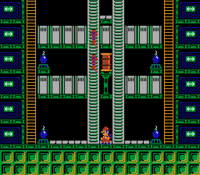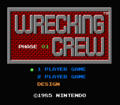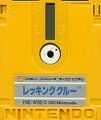Wrecking Crew
- This article is about the game for the Nintendo Entertainment System. For other uses, see Wrecking Crew (disambiguation).
Template:Infobox Wrecking Crew is one of the first Mario games, originally released in 1985 for the Family Computer in Japan and later that year for the Nintendo Entertainment System in North America, eventually making it to Europe in 1987. Wrecking Crew was released on the Wii's, Nintendo 3DS's, and Wii U's Virtual Console. It follows the VS. System version of the game called VS. Wrecking Crew which came out the previous year. In both games, the player controls Mario (Player 2 as Luigi) working on a demolition site. The goal is to break down all walls for demolition on each stage. However, this version is more focused on the puzzle platformer aspect and removed competitive play entirely as there is no simultaneous two-player mode.
Unlike the arcade version, this game also features a custom level maker, where players can make their own Wrecking Crew levels. The game had the ability to save those custom levels. However, the required peripherals (the keyboard and Data Recorder accessories) were released only in Japan, as the peripherals are only available in the Family BASIC accessory. The games Excitebike and Mach Rider have the same limitations as Wrecking Crew. This functionality was fully utilized in the Virtual Console rereleases of these games as they emulate the peripherals behind-the-scenes. However, this feature is not included in the Nintendo Switch Online version of the game. The Famicom Disk System version does not need the peripherals as it could save on the disk.
Gameplay
Unlike the arcade version, there is vertical scrolling but each stage still takes place in a single wraparound screen.
As the player tries to break all the walls with their hammer, they are attacked by various enemies. Defeating the enemies is not easy, as the regular hammer deals them no damage. If an enemy wanders underneath a dead-end drum, the player can trap it by causing the drum to fall. Sometimes Foreman Spike appears in the background and smashes walls himself. He can also try to push the player off the platforms, but if they can hit Foreman Spike with their hammer, Foreman Spike will fall down instead.
If the player breaks down the walls in a particular order, they may find letters that makes up the name of the character the player is playing. Finding all of these will give the player an extra life. In any level with three or more bombs, hitting three bombs in a specific order will reveal a prize. The type of prize is determined by adding the stage number with the number of swings Mario made during the stage then dividing by 8. If the remainder is 0, 3, or 6, a pig statue is revealed which can be smashed for 800 points. If the remainder is 2 or 5, a Santa Claus statue worth 1600 points with show up. If it is 4 or 7, a maneki-neko statue worth 3200 points will appear. If the remainder is 1, it will spawn a Golden Hammer, also worth 3200 points. Much more powerful than the regular hammer, the Golden Hammer allows the player to knock down walls much faster, and, if they time it right, they can knock enemies down to the bottom floor.
As well as brick walls, there are also girder stands that can be knocked out, ladder walls that can be used until they are destroyed (Foreman Spike can also destroy these), and bombs that will damage any bricks lined up with it (as well as knocking whoever is nearby off the platform if they do not move away fast enough).
In 2 Player Game, one player will take over after the other loses a life.
Characters
Playable
Enemies
Each level has various enemies that will attempt to stop Mario:
- Gotchawrench - a dinosaur wrench that chases Mario around the stage.
- Eggplant Man - a masked eggplant that sprints around, getting in Mario's way.
- Foreman Spike - the bearded foreman of the construction site. He will constantly try to stop Mario from completing his job by hitting the hero off the beams. He takes over the role Luigi did in the single player mode of the VS. version.
- Fireball - Spend too long in a particular area and a fireball will appear.
References to other games
- Mario Bros.: The fireball appears in levels if the player takes too long to complete the level.
References in later games
- Kid Icarus: Graphics designer Toru Osawa created the Eggplant Wizard in part as a tribute to Wrecking Crew's Eggplant Men, as well as his own love of eggplants[1].
- Mobile Golf: Foreman Spike reappears.
- Wrecking Crew '98: This game is a sequel to Wrecking Crew, a port of which is also included. All characters from the previous game are back.
- Super Smash Bros.: Mario's third color palette, with brown overalls and a white shirt, is said to be a reference to Foreman Spike[2]. This color option for Mario would return in all future installments. Also, Luigi's third color palette, with red overalls and a pink shirt is based on his sprite from the game.
- Super Smash Bros. Melee: The Eggplant Man reappears as a collectible trophy. Mario's Foreman Spike-inspired color palette returns and Luigi's pink color palette returns.
- Chibi-Robo!: The Eggplant Man reappears again, this time under the name "Kid Eggplant."
- WarioWare: Twisted!: 9-Volt has a microgame based off Wrecking Crew simply titled Wrecking Crew.
- Super Smash Bros. Brawl: The Golden Hammer and its theme are included in the game. Mario's Foreman Spike-inspired color palette returns and Luigi's pink color palette returns.
- Super Smash Bros. for Wii U: A Wrecking Crew stage appears in this game. Mario's Foreman Spike-inspired color palette returns and Luigi's pink color palette returns.
- Super Mario Maker: Foreman Spike is one of the 100 Mario Costumes in the game and also several jingles are also heard from this game when playing as him.
- WarioWare Gold: One of 9-Volt's microgames in this game is the basis of Wrecking Crew.
- Super Smash Bros. Ultimate: The Golden Hammer from Wrecking Crew returns in this game. Mario's Foreman Spike-inspired color and Luigi's pink color palette also returns.
Sequel
In 1998, Wrecking Crew '98 was released as a Japan-only game for the Super Famicom. Wrecking Crew '98 is competitive, giving each player their own side to clean up, and opportunity to use doors to send enemies to the opponent's side.
Staff
- Game Designer
- Yoshio Sakamoto
- Makoto Kano
- Original Music
- Hirokazu Tanaka
- Sound Department
- Hirokazu Tanaka
- Director
- Producer
- Programed by
- Toshiyuki Nakamura
- Tomoyo-chan
- Yase Sobajima
- Akina-chan
Gallery
Sprites
Screenshots
Famicom title screen
Box art / Virtual Console icons
- WC Famicom Box Art.jpg
Japanese box art
Media
References
- ^ Making of a Myth: The Grueling Development of the Original Kid Icarus. Nintendo World Report. Retrieved April 4, 2015.
- ^ Japanese Super Smash Bros. website lists Mario's 3P palette as "Blackey - FC Wrecking Crew". Retrieved April 4, 2015
| VS. Wrecking Crew / Wrecking Crew | |
|---|---|
| Characters | Mario • Luigi |
| Items and objects | Coin • Door • Druma • Dynamite • Floor • Golden Hammera • Ladder (Ladder wall) • Lettera • Pillara • Wall |
| Enemies | Eggplant Mana • Fireball • Foreman Spikea • Gotchawrench |






